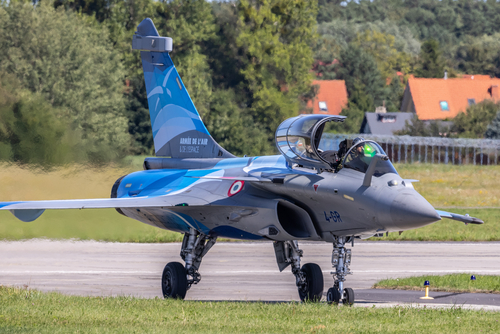
The French Dassault Rafale, a formidable fourth-generation multi-role fighter, has consistently showcased its prowess in the realm of air combat.

A recent training event in the United Arab Emirates brought the Rafale into a mock battle with a U.S. F-22 Raptor, highlighting the aircraft’s dogfighting capabilities. While the U.S. Air Force disputed the claim that the Rafale “shot down” the Raptor, the French released cockpit footage substantiating their success.

The Rafale’s impressive arsenal, including the Meteor air-to-air missile and SCALP-EG stand-off cruise missile, complements its state-of-the-art AESA radar capable of engaging multiple threats simultaneously.

With a speed of Mach 1.8 and the ability to refuel midair through its “buddy-buddy” system, the aircraft is a testament to France’s commitment to air dominance. The military plans to continue its service into the 2050s, signaling confidence in its sustained relevance.

On the opposing side, the Lockheed Martin F-22 Raptor remains a symbol of advanced tactical warfare with a mix of stealth, supercruise, and integrated avionics that define modern air superiority.

The Raptor, with its sophisticated sensor suite, provides first-kill opportunities against adversaries, leveraging its stealth and thrust vectoring capabilities to maintain an edge in combat.

Despite its prowess, the F-22 Raptor has faced several challenges in training scenarios against less-advanced aircraft, such as the F-16 and the Navy’s EA-18G Growler.

German Eurofighter Typhoons have also claimed victories over the Raptor during Red Flag air combat exercises. These incidents prompt discussions about the Raptor’s capabilities and the context in which these engagements occur.

Training exercises often intentionally handicap more advanced aircraft like the F-22 to provide learning opportunities for pilots. Rules of engagement during exercises can neutralize advantages such as stealth and beyond-visual-range capabilities to level the playing field.

In some instances, Raptors are required to carry fuel-heavy drop tanks that impair their maneuverability, offering adversaries like the FA-50 light attack jets opportunities to engage on more equal terms.

This approach to training reflects a commitment to maximizing the educational value of exercises rather than simply demonstrating air dominance.

The mock engagements serve as a reminder that operational conditions, rules of engagement, and the objectives of training significantly impact the outcomes of such exercises.

The incident between the Rafale and the Raptor, much like the scenario involving the Philippine FA-50, underscores the complex dynamics of modern air combat training.

While the Rafale’s engagement with the F-22 offers a glimpse of its capabilities, the full context of the event reveals the nuanced nature of air combat exercises and the strategic considerations that underpin them.

As nations continue to evolve their aerial combat platforms and tactics, such training engagements will remain essential to preparing pilots for the multifaceted challenges of real-world operations.
